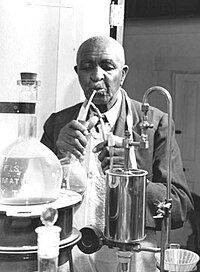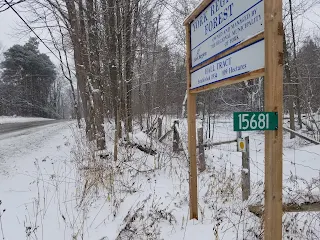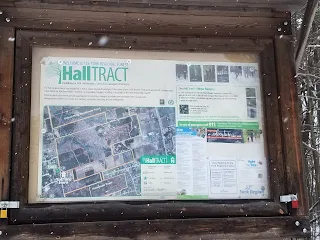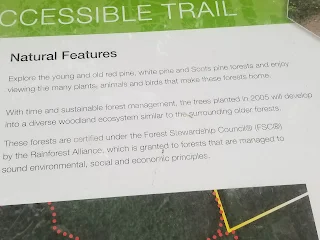George Washington Carver was born into slavery in Diamond Grove, Newton County, near Crystal Place, now known as Diamond, Missouri, sometime in the early 1860s. The exact date of his birth is uncertain and was not known to Carver – however, it was sometime before slavery was abolished in Missouri in January 1865. His master, Moses Carver, was a German American immigrant who had purchased George's parents, Mary and Giles, from William P. McGinnis on October 9, 1855, for $700.
When George was only a week old, he, a sister, and his mother were kidnapped by night raiders from Arkansas. George's brother, James, was rushed to safety from the kidnappers. The kidnappers sold the slaves in Kentucky. Moses Carver hired John Bentley to find them, but he located only the infant George. Moses negotiated with the raiders to gain the boy's return and rewarded Bentley.
After slavery was abolished, Moses Carver and his wife Susan raised George and his older brother James as their own children. They encouraged George to continue his intellectual pursuits, and "Aunt Susan" taught him the basics of reading and writing.
Black people were not allowed at the public school in Diamond Grove. George decided to go to a school for black children 10 miles (16 km) south of Neosho. When he reached the town, he found the school closed for the night. He slept in a nearby barn. By his own account, the next morning he met a kind woman, Mariah Watkins, from whom he wished to rent a room. When he identified himself as "Carver's George," as he had done his whole life, she replied that from now on his name was "George Carver".
George liked Mariah Watkins, and her words, "You must learn all you can, then go back out into the world and give your learning back to the people", made a great impression on him.
At the age of 13, due to his desire to attend the academy there, he relocated to the home of another foster family in Fort Scott, Kansas. After witnessing a black man killed by a group of whites, Carver left the city. He attended a series of schools before earning his diploma at Minneapolis High School in Minneapolis, Kansas.
Carver applied to several colleges before being accepted at Highland University in Highland, Kansas. When he arrived, however, they rejected him because of his race. In August 1886, Carver travelled by wagon with J. F. Beeler from Highland to Eden Township in Ness County, Kansas. He homesteaded a claim near Beeler, where he maintained a small conservatory of plants and flowers and a geological collection. He manually plowed 17 acres (69,000 m2) of the claim, planting rice, corn, Indian corn and garden produce, as well as various fruit trees, forest trees, and shrubbery. He also earned money by odd jobs in town and worked as a ranch hand.
In early 1888, Carver obtained a $300 loan at the Bank of Ness City for education. By June he left the area.
When he began there in 1891, he was the first black student. Carver's Bachelor's thesis was "Plants as Modified by Man", dated 1894.
Iowa State professors Joseph Budd and Louis Pammel convinced Carver to continue there for his master's degree. Carver did research at the Iowa Experiment Station under Pammel during the next two years. His work at the experiment station in plant pathology and mycology first gained him national recognition and respect as a botanist. Carver taught as the first black faculty member at Iowa State.
In 1896, Booker T. Washington, the first principal and president of the Tuskegee Institute (now Tuskegee University), invited Carver to head its Agriculture Department. Carver taught there for 47 years, developing the department into a strong research centre and working with two additional college presidents during his tenure. He taught methods of crop rotation, introduced several alternative cash crops for farmers that would also improve the soil of areas heavily cultivated in cotton, initiated research into crop products (chemurgy), and taught generations of black students farming techniques for self-sufficiency.
After becoming the institute’s director of agricultural research in 1896, Carver devoted his time to research projects aimed at helping Southern agriculture, demonstrating ways in which farmers could improve their economic situation. He conducted experiments in soil management and crop production and directed an experimental farm.
At this time agriculture in the Deep South was in steep decline because the unremitting single-crop cultivation of cotton had left the soil of many fields exhausted and worthless, and erosion had then taken its toll on areas that could no longer sustain any plant cover. As a remedy, Carver urged Southern farmers to plant peanuts (Arachis hypogaea) and soybeans (Glycine max).
As members of the legume family (Fabaceae), these plants could restore nitrogen to the soil while also providing the protein so badly needed in the diet of many Southerners.
Carver found that Alabama’s soils were particularly well-suited to growing peanuts and sweet potatoes (Ipomoea batatas), but when the state’s farmers began cultivating these crops instead of cotton, they found little demand for them on the market. In response to this problem, Carver set about enlarging the commercial possibilities of the peanut and sweet potato through a long and ingenious program of laboratory research.
He ultimately developed 300 derivative products from peanuts—among them milk, flour, ink, dyes, plastics, wood stains, soap, linoleum, medicinal oils, and cosmetics—and 118 from sweet potatoes, including flour, vinegar, molasses, ink, a synthetic rubber, and postage stamp glue.
When George was only a week old, he, a sister, and his mother were kidnapped by night raiders from Arkansas. George's brother, James, was rushed to safety from the kidnappers. The kidnappers sold the slaves in Kentucky. Moses Carver hired John Bentley to find them, but he located only the infant George. Moses negotiated with the raiders to gain the boy's return and rewarded Bentley.
After slavery was abolished, Moses Carver and his wife Susan raised George and his older brother James as their own children. They encouraged George to continue his intellectual pursuits, and "Aunt Susan" taught him the basics of reading and writing.
Black people were not allowed at the public school in Diamond Grove. George decided to go to a school for black children 10 miles (16 km) south of Neosho. When he reached the town, he found the school closed for the night. He slept in a nearby barn. By his own account, the next morning he met a kind woman, Mariah Watkins, from whom he wished to rent a room. When he identified himself as "Carver's George," as he had done his whole life, she replied that from now on his name was "George Carver".
George liked Mariah Watkins, and her words, "You must learn all you can, then go back out into the world and give your learning back to the people", made a great impression on him.
At the age of 13, due to his desire to attend the academy there, he relocated to the home of another foster family in Fort Scott, Kansas. After witnessing a black man killed by a group of whites, Carver left the city. He attended a series of schools before earning his diploma at Minneapolis High School in Minneapolis, Kansas.
College
At work in his laboratory
In early 1888, Carver obtained a $300 loan at the Bank of Ness City for education. By June he left the area.
When he began there in 1891, he was the first black student. Carver's Bachelor's thesis was "Plants as Modified by Man", dated 1894.
Iowa State professors Joseph Budd and Louis Pammel convinced Carver to continue there for his master's degree. Carver did research at the Iowa Experiment Station under Pammel during the next two years. His work at the experiment station in plant pathology and mycology first gained him national recognition and respect as a botanist. Carver taught as the first black faculty member at Iowa State.
In 1896, Booker T. Washington, the first principal and president of the Tuskegee Institute (now Tuskegee University), invited Carver to head its Agriculture Department. Carver taught there for 47 years, developing the department into a strong research centre and working with two additional college presidents during his tenure. He taught methods of crop rotation, introduced several alternative cash crops for farmers that would also improve the soil of areas heavily cultivated in cotton, initiated research into crop products (chemurgy), and taught generations of black students farming techniques for self-sufficiency.
After becoming the institute’s director of agricultural research in 1896, Carver devoted his time to research projects aimed at helping Southern agriculture, demonstrating ways in which farmers could improve their economic situation. He conducted experiments in soil management and crop production and directed an experimental farm.
At this time agriculture in the Deep South was in steep decline because the unremitting single-crop cultivation of cotton had left the soil of many fields exhausted and worthless, and erosion had then taken its toll on areas that could no longer sustain any plant cover. As a remedy, Carver urged Southern farmers to plant peanuts (Arachis hypogaea) and soybeans (Glycine max).
As members of the legume family (Fabaceae), these plants could restore nitrogen to the soil while also providing the protein so badly needed in the diet of many Southerners.
Carver found that Alabama’s soils were particularly well-suited to growing peanuts and sweet potatoes (Ipomoea batatas), but when the state’s farmers began cultivating these crops instead of cotton, they found little demand for them on the market. In response to this problem, Carver set about enlarging the commercial possibilities of the peanut and sweet potato through a long and ingenious program of laboratory research.
He ultimately developed 300 derivative products from peanuts—among them milk, flour, ink, dyes, plastics, wood stains, soap, linoleum, medicinal oils, and cosmetics—and 118 from sweet potatoes, including flour, vinegar, molasses, ink, a synthetic rubber, and postage stamp glue.







































































































